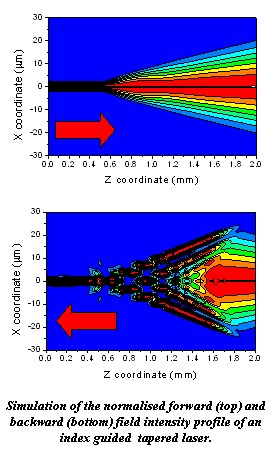

World Wide Welfare:
high BRIGHTness
semiconductor lasER for
gEneric Use
high BRIGHTness
semiconductor lasER for
gEneric Use
Partner 15 - Universidad Politécnica de Madrid (UPM)
The Universidad Politécnica de Madrid (Technical University of Madrid) is the largest academic institution in Spain devoted to education and research in engineering and applied sciences.
Its more than 4000 faculty staff personnel and PhD students participate in research and development projects founded by local, national and European institutions both public and private.
Since 1998 UPM is one of the most active European institutions in the EU Framework Programs: it participated in 162 projects of FP5 with a total funding of around 24 M€. At present, it is involved in 56 projects in the FP6 in different thematic priorities.
UPM is participating in WWW.BRIGHTEU through the “Applied Photonic Group” at the “Departamento de Tecnología Fotónica” (Photonic Technology Dept.).
The group started its activity in semiconductor lasers in 1992 and since then it has conducted research in this activity in different European projects (NODELASE 1996-99, ULTRABRIGHT 2000-03, WWW.BRIGHT.EU 2004-06) and national projects in collaboration with international and national groups.
The main research fields of the group in the last years have been: modelling of high speed laser dynamics, including carrier capture and escape balance, new techniques for laser diode characterisation (Capacitance–Voltage, sub-threshold Power-Cur-rent -Voltage measurements, spatially resolved spectral analysis, gain and linewidth enhancement factor measurements), modelling of high brightness tapered lasers, and modelling and applications of VCSELs.
The group has published more than 100 journal and conference papers on laser diodes, and has developed and registered a software program for the simulation of High Power Lasers (HAROLD 3.0) which is currently under commercial exploitation.
Its more than 4000 faculty staff personnel and PhD students participate in research and development projects founded by local, national and European institutions both public and private.
Since 1998 UPM is one of the most active European institutions in the EU Framework Programs: it participated in 162 projects of FP5 with a total funding of around 24 M€. At present, it is involved in 56 projects in the FP6 in different thematic priorities.
UPM is participating in WWW.BRIGHTEU through the “Applied Photonic Group” at the “Departamento de Tecnología Fotónica” (Photonic Technology Dept.).
The group started its activity in semiconductor lasers in 1992 and since then it has conducted research in this activity in different European projects (NODELASE 1996-99, ULTRABRIGHT 2000-03, WWW.BRIGHT.EU 2004-06) and national projects in collaboration with international and national groups.
The main research fields of the group in the last years have been: modelling of high speed laser dynamics, including carrier capture and escape balance, new techniques for laser diode characterisation (Capacitance–Voltage, sub-threshold Power-Cur-rent -Voltage measurements, spatially resolved spectral analysis, gain and linewidth enhancement factor measurements), modelling of high brightness tapered lasers, and modelling and applications of VCSELs.
The group has published more than 100 journal and conference papers on laser diodes, and has developed and registered a software program for the simulation of High Power Lasers (HAROLD 3.0) which is currently under commercial exploitation.
Activities in WWW.BRIGHT-EU
The activity of UPM in the project consists of the modelling, simulation and design of optimised tapered lasers emitting at several wavelengths in the near infrared.
The final goals of this activity are twofold. The first goal is to provide the fabricating partners with design recommendations of tapered lasers with optimised brightness.
The second goal is to gain, based on simulations, an understanding of the underlying physics that determines the behaviour of the devices, which will help in the optimisation of the design.
UPM and UNott in a collaborative work have developed a steady state simulation tool (ILDSP) in the framework of a previous project (ULTRA-BRIGHT), that has demonstrated to be able to predict the behaviour of several tapered lasers.
A first task of UPM in the project is to simulate with the ILDSP tapered lasers at 975 nm and 915 nm with different geometries and different epitaxial layer structures to seek an optimised design.
A second task, in collaboration with UNott, is the upgrading of ILDSP by incorporating capabilities for the simulation of lasers with new geometries (built-in lenses, curved mirrors).
Finally, a third task (also in collaboration with UNott) is to use the upgraded tool to perform simulations and provide the fabricating partners with design recommendations for the new devices.
For further information please contact: Professor Ignacio Esquivias Tel: +34913367339. (esquivia@tfo.upm.es)
The activity of UPM in the project consists of the modelling, simulation and design of optimised tapered lasers emitting at several wavelengths in the near infrared.
The final goals of this activity are twofold. The first goal is to provide the fabricating partners with design recommendations of tapered lasers with optimised brightness.
The second goal is to gain, based on simulations, an understanding of the underlying physics that determines the behaviour of the devices, which will help in the optimisation of the design.
UPM and UNott in a collaborative work have developed a steady state simulation tool (ILDSP) in the framework of a previous project (ULTRA-BRIGHT), that has demonstrated to be able to predict the behaviour of several tapered lasers.
A first task of UPM in the project is to simulate with the ILDSP tapered lasers at 975 nm and 915 nm with different geometries and different epitaxial layer structures to seek an optimised design.
A second task, in collaboration with UNott, is the upgrading of ILDSP by incorporating capabilities for the simulation of lasers with new geometries (built-in lenses, curved mirrors).
Finally, a third task (also in collaboration with UNott) is to use the upgraded tool to perform simulations and provide the fabricating partners with design recommendations for the new devices.
For further information please contact: Professor Ignacio Esquivias Tel: +34913367339. (esquivia@tfo.upm.es)

[Home] [Project] [Participants] [Newsletters] [Publications] [Workshops] [Tutorials] [More...] [Private] [Legal notice]
